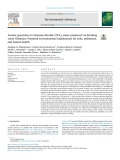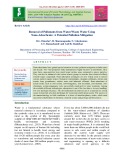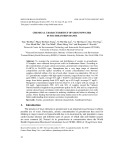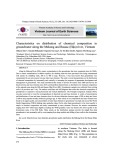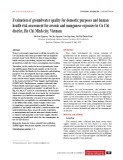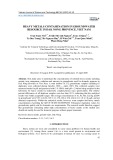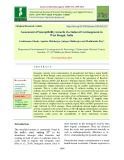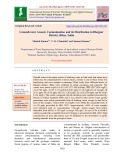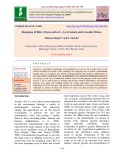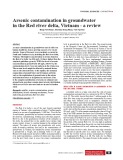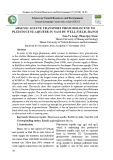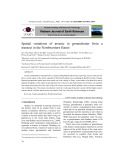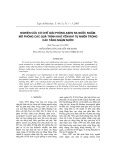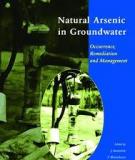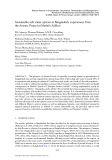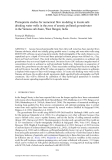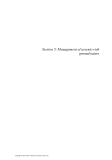
Arsenic in groundwater
-
Synchrotron-based X-ray absorption spectroscopy (XAS), specifically X-ray absorption near edge structure (XANES) spectroscopy, indicated the dominant species of As in soil and sediment samples was arsenate [As(V)], which is similar to the chemical form of As in the groundwaters of this region. No evidence of arsenite [As(III)] was identified in any of the solid-phase samples, including earthworm castings.
 10p
10p  thebadguys
thebadguys
 15-01-2022
15-01-2022
 11
11
 0
0
 Download
Download
-
Removal of pollutants from water/waste water using nano-adsorbents: A potential pollution mitigation
Nano-adsorbents have gained special attention in water pollution mitigation in India since last decade. Two vital properties make nanoparticles highly lucrative as adsorbents. On a mass basis, nano-particles have much larger surface areas compared to macro particles. They can also be enhanced with various reactor groups to increase their chemical affinity towards target compounds. Nano-adsorption techniques are now widely used to remove cations, natural organic matter, biological contaminants, inorganic pollutants, nitrates and arsenic from groundwater, surface water and industrial effluents.
 5p
5p  cothumenhmong9
cothumenhmong9
 04-01-2021
04-01-2021
 18
18
 1
1
 Download
Download
-
Arsenic showed poor correlations with other compositions in groundwater even with the parameters which are common in reducing conditions and relate to releasing of arsenic. These finding showed that more deep studies need to be carried out to have better understanding about arsenic occurrence in groundwater.
 8p
8p  tamynhan9
tamynhan9
 02-12-2020
02-12-2020
 11
11
 3
3
 Download
Download
-
This study summarized the results of surveys for arsenic since 2008 and surveys for dissolved ions and trace elements since 2015, and described characteristics on distribution for chemical composition at the regional areas along the MR and Bassac (Hậu) River (BR). Groundwater samples were collected from existing wells in 8 provinces and 1 city. The authors used Piper and Stiff diagram that reflect the chemical composition of groundwater to respond to varying horizontal and vertical distributions.
 17p
17p  nguyentanloc09
nguyentanloc09
 17-10-2020
17-10-2020
 11
11
 1
1
 Download
Download
-
This study investigated the current situation of groundwater use for domestic purposes and consumption. The research team collected data from several centralized water supply stations operated by the CERWASS. The team also conducted surveys and took water samples from 94 households and water supply stations. The evaluation of groundwater quality and its suitability for domestic use was also conducted. The results showed that in terms of raw water quality, most of the samples had low iron (Fe) concentration and pH value.
 7p
7p  kethamoi7
kethamoi7
 15-08-2020
15-08-2020
 27
27
 3
3
 Download
Download
-
This study aims to understand the concentrations of selected heavy metals including arsenic, iron, manganese, cadmium and mercury in groundwater used for domestic purposes in Dak Nong Province of Viet Nam. A total number of 572 groundwater samples including 61 duplicates were collected during October, 2018 – April, 2019. The collected samples were measured onsite for pH and preserved with 2 % HNO3 until pH < 2 before being analyzed in the laboratory for heavy metals by inductively coupled plasma mass spectrometry.
 8p
8p  angicungduoc5
angicungduoc5
 13-06-2020
13-06-2020
 9
9
 0
0
 Download
Download
-
Inorganic Arsenic (iAs) contamination of groundwater had been a major health hazard. In West-Bengal, many areas had been found to have high level of iAs in groundwater. Chronic exposure to iAs may lead to the generation of Reactive Oxygen Species (ROS) and Reactive Nitrogen Species (RNS). This results in DNA damage, inflammation, impairment of repair activity, thereby culminating in carcinogenesis. Higher telomerase activity may be another manifestation of iAs exposure. This is a pilot study involving 15 subjects residing in an arsenic endemic area of West-Bengal.
 14p
14p  caygaocaolon4
caygaocaolon4
 04-04-2020
04-04-2020
 15
15
 1
1
 Download
Download
-
Ground water is the major source of drinking water in both rural and urban areas which may be contaminated by various means, Arsenic is one of them. Forty five hand-pump and river samples (containing 250ml each) from different blocks of Bhojpur district, Bihar were collected in sterile containers and analyzed.
 12p
12p  caygaocaolon2
caygaocaolon2
 14-03-2020
14-03-2020
 9
9
 0
0
 Download
Download
-
Arsenic is a potential contaminant of groundwater as well as soil in many parts of the world. Elevated soil arsenic levels resulting from long-term use of arsenic contaminated ground water for irrigation may inhibit seed germination and seedling establishment of rice, the country’s main food crop. An experiment was conducted to determine response of rice (Oryza sativa L) to arsenate and arsenite stress. For this purpose seeds were treated with 0, 5, 10, 15 and 20 ppm of arsenate and arsenite solution individually.
 5p
5p  cothumenhmong1
cothumenhmong1
 08-12-2019
08-12-2019
 11
11
 0
0
 Download
Download
-
Arsenic contamination in groundwater and its effect on human health has been a growing concern over recent decades. Some of the most severe incidents occurred in South and Southeast Asia, including the Red river delta, Vietnam. The highest concentration of arsenic found in the Red river delta was 810 µg/L, 16 times higher than the standard guidelines given by WHO for levels of arsenic concentration in groundwater (50 µg/L). However, the contamination levels were not uniform in the whole area.
 5p
5p  caygaocaolon1
caygaocaolon1
 13-11-2019
13-11-2019
 12
12
 2
2
 Download
Download
-
In many of the large Quaternary delta systems in Southeast Asia, groundwater in the shallow Holocene aquifer contains elevated concentrations of arsenic (As). In anoxic sediments, reduction of As bearing Fe-oxides by organic matter oxidization, releases As to the groundwater
 8p
8p  vithanos2711
vithanos2711
 08-08-2019
08-08-2019
 56
56
 1
1
 Download
Download
-
Arsenic (As) contamination in groundwater has been recognized in the Mekong River Delta (MRD) since 2001, especially in Dong Thap and An Giang provinces. The investigations were carried out during 2008-2009 and from 2012 to present. The investigations of As distribution in groundwater and sediments were based upon the field, and laboratory analyses using field kit (Hironaka, 1998) and AOAC laboratory - Vietnamese standard 6626-2000 (Vilas).
 10p
10p  meolep4
meolep4
 02-01-2019
02-01-2019
 24
24
 1
1
 Download
Download
-
In this study, the groundwater from a transect in the Northwestern area of Hanoi was examined. The results showed that 28.8% the wells of the B-B’ transect exceed the WHO guideline value for arsenic concentration in drinking water. The arsenic concentrations varied in a wide range from point to point, with the highest concentration found at Van Phuc and the lowest one found at Cam Yen. They also varied accordingly to the depth.
 8p
8p  meolep1
meolep1
 28-11-2018
28-11-2018
 19
19
 1
1
 Download
Download
-
In recent several years there were publications of arsenic contamination in groundwater. This event actuated us to study and explain the mechanism of arsenic releasing into groundwater of aquifers under alluvial plains. Understanding of this mechanism could make clear of the relations between solid phase (arsenic-bearing material) and water phase (arsenic dissolvable) in earth crust layers.
 5p
5p  uocvong04
uocvong04
 24-09-2015
24-09-2015
 46
46
 3
3
 Download
Download
-
The presence of substances in groundwater may be affected by naturally occurring processes as well as by actions directly associated with human activities. Naturally occurring processes such as decomposition of organic material in soils or leaching of mineral deposits can result in increased concentrations of several substances. Those of health concern include arsenic, fluoride, selenium, uranium, nitrate, metals, and radionuclides such as radon. Problems of aesthetic quality and acceptance may be caused by iron, manganese, sulphate, chloride and organic matter. ...
 50p
50p  cao_can
cao_can
 29-12-2012
29-12-2012
 59
59
 5
5
 Download
Download
-
Natural variations in pH and oxygen status are also important and are not restricted to deep environments. Many groundwaters in tropical regions in weathered basement aquifers and alluvial sequences have low pH, and the reducing conditions which prevail can promote the mobilisation of metals and other parameters of health significance such as arsenic.
 36p
36p  cao_can
cao_can
 29-12-2012
29-12-2012
 53
53
 4
4
 Download
Download
-
Groundwater is an important resource that serves as a backbone of human development. In several regions, mostly in developing countries, groundwater from sedimentary and hard rock aquifers used for drinking is naturally contaminated with arsenic. In different countries in Asia such as India, Bangladesh, Cambodia, China, Nepal, Pakistan, Taiwan, Thailand and Vietnam, the situation of arsenic toxicity is alarming and severe health problems are reported amongst the inhabitants relying on groundwater as sources of water for drinking purposes....
 299p
299p  951628473
951628473
 07-05-2012
07-05-2012
 87
87
 24
24
 Download
Download
-
Sự hiện diện của các cấp cao của tự nhiên asen trong nước ngầm của Bangladesh, đã bị suy giảm nghiêm trọng các nỗ lực thập kỷ dài cung cấp nước sạch cho gần 98% dân số và đưa 35 triệu người, gần 1 / 4 tổng dân số â € " có nguy cơ. Để giải quyết vấn đề này, một dự án mang tên â € œArsenic trong tubewell (TW) nước và sức khỏe hậu quả trong Matlab Upazila huyện Chandpur (AsMat) - đang được thực hiện do ICDDR, B và BRAC. Trong nghiên cứu này. tất cả các TWS trong Matlab đã...
 12p
12p  bengoan741
bengoan741
 23-12-2011
23-12-2011
 58
58
 8
8
 Download
Download
-
Asen vượt quá giới hạn cho phép từ nước giếng ống đã được báo cáo từ các tiểu lưu vực sông Yamuna, bước đầu đã đem lại cho nước uống. Vị nước giếng ống an toàn bằng cách sử dụng phần mềm MODFLOW có thể cung cấp cho khắc phục lâu dài. Hydrostratigraphy của lĩnh vực nghiên cứu là khái niệm độ sâu 140 m và ba nhóm trầm tích chủ yếu được xác định tức, đất sét, cát, và cát sỏi. Nghiên cứu này chỉ ra rằng nồng độ asen trong trầm tích và nước ngầm không tiết lộ...
 8p
8p  bengoan741
bengoan741
 23-12-2011
23-12-2011
 57
57
 6
6
 Download
Download
-
Asen ô nhiễm nước ngầm ở Bangladesh đã nổi lên như trường hợp ô nhiễm nước lớn nhất trên thế giới. Ở Bangladesh, nó đã được nghĩ rằng hơn 97% dân số đã tiếp cận với nước uống an toàn cho đến gần đây và bởi vì phát hiện asen trong nước ngầm, nguồn nước uống ở các vùng nông thôn và thành thị, truy cập đã giảm đến 80 %. Sự gia tăng gần đây trong sản xuất lúa gạo cũng là do nước ngầm để tưới tiêu và khoảng 70% nước tưới là trừu tượng từ các tầng...
 15p
15p  bengoan741
bengoan741
 23-12-2011
23-12-2011
 59
59
 9
9
 Download
Download
CHỦ ĐỀ BẠN MUỐN TÌM








